
The Layburys Creek Tidal Watermill
aka Gunderman, Laybury Creek, Laybury's Creek, Asterly, Asterley, Singleton's Mill
Singleton Mills homepage > Wisemans Ferry Mills > The Laybury Creek Mill
The third tidal flour mill that James Singleton established in the Wisemans Ferry area was built on Portion 17 in the parish of Frederick.
Ruins on the site
The remaining traces of this mill have been greatly altered. The dam for this mill was built across the mouth of Layburys Creek and the waterwheel was mounted in a channel through the dam wall. The mouth of Layburys Creek was originally much wider than it is today and a substantial piece of land has been reclaimed in recent years, where the dam wall used to be.
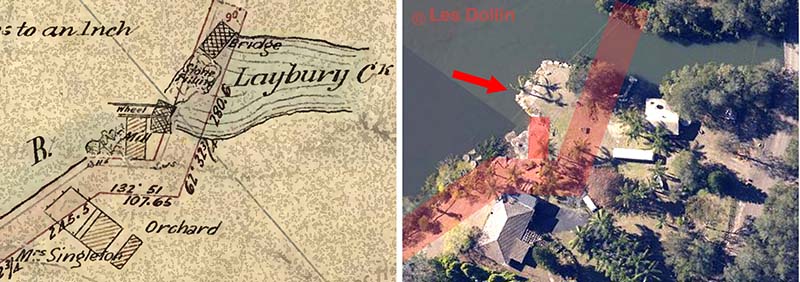
Above left: a plan of the Laybury Creek mill, waterwheel, stone filling of the dam wall, bridge and proposed route of a road, shown on a roadplan dated 1894. Above right: a current aerial photograph of the mill site. The light red shading indicates the footprint of the old mill and of the proposed road, superimposed over modern features of the property. The mouth of Laybury Creek was originally much wider than it is now, and the northern end of the mill used to stand on foundations built in the creek. A substantial amount of land (red arrow) has been reclaimed from the mouth of Laybury Creek in recent years. Note: the mill and millhouse sites are on private land.
Deep grooves in a slab of sandstone near the site of the mill building may be the remains of a wharf beside the mill.

Above: these deep grooves in a rock shelf beside the river, photographed by Les Dollin in 2007, may be the remains of a wharf beside the mill.
Large blocks of sandstone that may have been from the mill structure can still be seen in garden areas of the property.
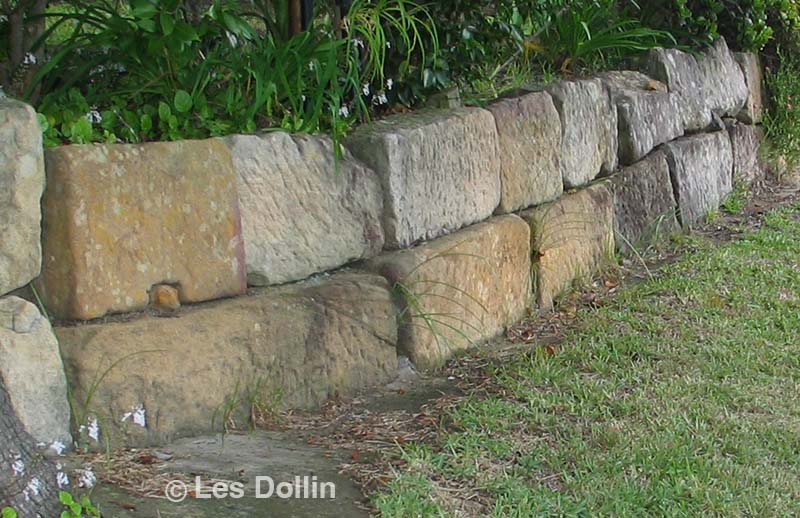
Above: large hewn blocks of sandstone photographed in 2007 on the site may be from the mill foundations. Photograph by Les Dollin.
In 2007 a set of rough steps leading down to the river were recorded, hewn from a solid sandstone rock shelf.
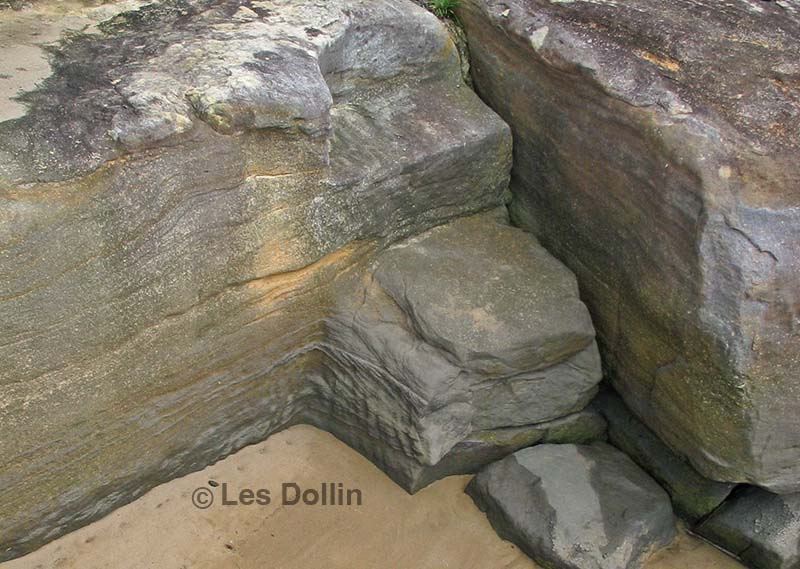
Above: steps cut from solid rock, leading down to the river. Photographed by Les Dollin in 2007.
in 2007 a staircase that appears to have been constructed from pieces of a millstone was also recorded on the site.
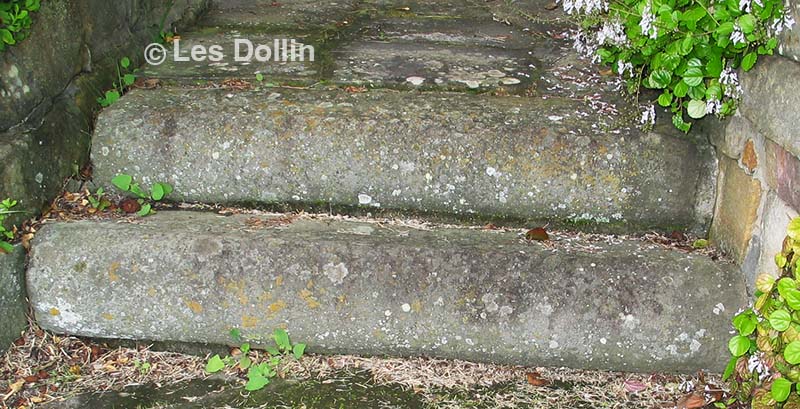
Above: steps that may have been cut from old millstones. Photographed by Les Dollin in 2007.
Descriptions of mill
This mill, known as Singleton's Mill, was still standing until the early 1900s and became a local landmark on the Hawkesbury River. It was clearly visible from vessels sailing along the river. Excellent photographs survive of the mill in its later years.
Visit our full gallery of 19 historic paintings and photographs |

Above: this is one of a set of photographs of the Laybury Creek Mill taken by William Frederick Hall between 1889 and 1909. From the Australian Maritime Museum collection on Flickr.
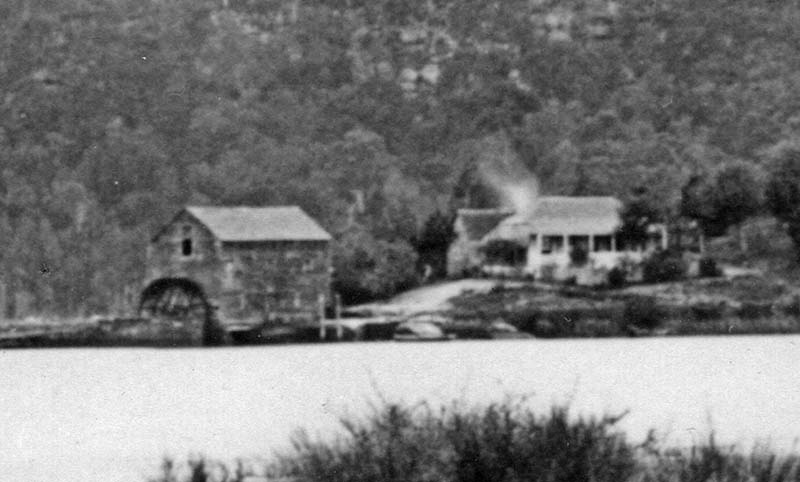
Above: this is a rare photograph of the other side of the Laybury's Creek Mill. A wharf can be seen beside the mill, as well as detail of the wall on the river side of the building. The millhouse appears to be occupied with smoke coming from the chimney in the detached kitchen behind the house. Photograph from the Jocelyn and John Powell collection, kindly supplied by the Dharug & Lower Hawkesbury Historical Society.
Further good descriptions of the mill have been found in advertisements in newspapers of the time:
The Australasian Chronicle, 31 August 1841, described the property as follows: 5 acres, with a garden and small paddock.
The Mill is built on a rock foundation. It has an undershot wheel, powering two pairs of French Burr stones, one 4’6” diameter and one 4’, with dressing and smut machine. The 4’6” stones are at work grinding eight to ten bushels per hour [290-360 litres]. The mill can house 2,000 bushels of grain [over 70 cubic metres].
The Millhouse has a verandah and is built from weatherboard and shingles, on a rock foundation. Three front rooms, two back rooms.
The Cumberland Argus and Fruitgrowers Advocate, 10 October 1908, described a visit by students from Granville Technical School to the mill in that year. The article states: "Originally, nearly the whole of the mill-gear was made of wood, all the wheels, bosses, arms and rims, as well as teeth (two pinions have since been replaced by cast-iron ones), most of the shafts, some of them being huge beams over 20 inches square, and all the pulleys."
Ralph Hawkins, a former archivist of the Society of Australian Genealogists, researched the history of the mill at Laybury Creek in detail and published his findings in 2019 in a downloadable article entitled, Singletons Mill Hawkesbury River.
Ralph told us (R. Hawkins Pers. comm. 7 July 2023) that he had measured a number of 19th Century timber buildings and found that, 'Generally speaking floorboards are sawn to 6” wide and may be planed down to 5½”, weatherboards may be 6½” wide and overlap by ½” -¾”, wall studs are generally spaced 18” apart and are sometimes housed in the bottom wall plate using mortise and tenon joints. Sheets of corrugated iron are around 32” wide and shingles mostly 3½” wide.'
Based on these statistics and the detailed photos which are available of the old Singletons Mill, Ralph Hawkins calculated that:
-- The length of the mill building was 27' [8m]
-- The height of the building to the apex of the roof was around 28' 6" [8.7m]
-- The height of the ground floor was between 9' 6" and 10' [2.3 - 3m]
-- The height of the second floor up to the eaves was between 10' 6" and 11' [3.2 – 3.4m]
As Ralph commented, 'the measurements might not be deadly accurate but the do give a feel for the building.' He also noted that the waterwheel had a diameter of 5 metres.
History of the mill
On 24 November 1830, James Singleton was promised five acres of land by Governor Darling as a special reserve for erecting a water mill. Possession of the land was given to James Singleton on 6 September 1831. The land grant was finally formally issued to James Singleton on 11 June 1841.
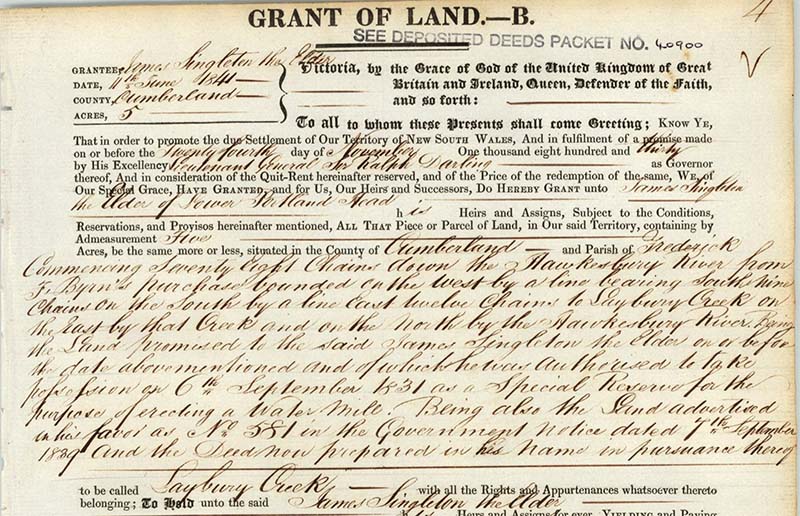
Above: James Singleton' formal grant in 1841 for the five acres of land where he established the Laybury Creek mill: "Special reserve for the purpose of erecting a Water Mill."
James Singleton also purchased other portions of land surrounding the five acre mill site at Laybury Creek.
A precise construction date is known for the mill at Laybury Creek because Mrs Sarah Felton Mathew visited the site in 1834 and saw it being built. Mrs Felton Mathew was the wife of the then Assistant Surveyor who was assigned to survey land in this area. She made intrepid journeys with her husband as he did his work and she described them in a fascinating journal. They travelled in sailing ships up the rivers and camped in rough tents in very remote areas.
Mrs Felton Mathew wrote in her journal on 5 February 1834:
"Proceeded up the river as far as the creek I have before mentioned opposite Gunderman Creek, intending to camp on the spot we had before occupied at its entrance, but here we found a small house had spring up, on the very site of our camp, and a mill was building, we therefore proceeded up the Creek, which I find is called Laybury's Creek, ..."
Source: Mrs Felton Mathew’s Journal, by Olive Harvard (1943), JRAHS, Vol. 29 (4), page 221.
Thomas Greentree was recorded living at 'Laybary' Creek in the 1841 Census of NSW.
"Messrs. Sawkins and Company" were apparently managing both this mill and the Dillons Creek Mill in 1843, according to an article in The Sydney Morning Herald, 30 January 1843. From the 1860s to the 1890s, Thomas Sawkins and his son were engaged in flour milling at Singleton, NSW.
The name Asterley's Mill or Asterly's Mill was used for this mill in the 1850s. Joseph and Emma Asterley were mortgage-holders of the property during that period.
James Singleton Junior (1814-1890) took over the mill in 1849, when his father, James Singleton Senior (ca. 1776-1849) died.
According to The Australian Town and Country Journal on 2 September 1903, the mill ground wheat and maize continuously until the great flood of 1867, when the mill sustained great damage and fell into disuse.
James Singleton Junior died in 1890 and his wife, Sarah, continued to live on one of their properties near the mill site until at least 1895. After her death in 1906, the property was inherited by Hedley Arthur Singleton, the nephew of James Singleton Junior.
At that point, the Singleton family had for maintained a long association with this area for sixty years and the locality is still called Singletons Mill today.
Further Reading
• The Wisemans Ferry Mills • Nagles Creek Mill • Dillons Creek Mill